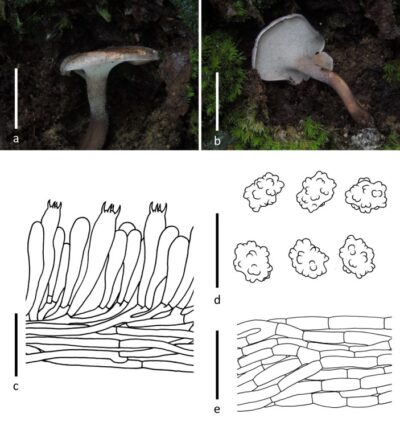Fungalpedia – Note 344, Hydnellum
Hydnellum P. Karst.
Citation if using this entry: Khyaju et al. 2025 (in prep.) – Fungalpedia, Basidiomycota 4, Mycosphere
Index Fungorum, Faceofungi, Mycobank, GenBank Fig.1
Classification: Bankeraceae, Thelephorales, Incertae sedis, Agaricomycetes,Agaricomycotina, Basidiomycota, Fungi.
Hydnellum P. Karst is a hydnoid mushroom genus that was established by P. Karst. in 1879, and it is typified by Hydnellum suaveolens (Scop.) P. Karst (Maas 1975, Loizides et al. 2016). Hydnellum is an important genus within the Bankeracea and is well known for forming ectomycorrhizal associations with woody plants, particularly those in the Pinaceae and Fagaceae families (Nitare et al. 2021, Mu et al. 2021, Song et al. 2022). Hydnellum species have a cosmopolitan distribution, mainly distributed in Asia, Europe, and North America, with a few species reported from Oceania (Maas 1975, Loizides et al. 2016). There are over 130 records in Index Fungorum (2024).
Hydnellum is characterized by stipitate and corky to woody basidiocarps, spinous hymenophore, irregularly ellipsoidal to globose spores with tuberculate, the surface of pileus scaled or unscaled, background banded or un-banded, and some taxa showing olive or blue-green colour in KOH (Maas 1975, Baird & Khan 1986, Baird et al. 2013, Mu et al. 2021). Hydnellum is very similar to Sarcodon because of the similar basidiomata with a hymenium made up of spines and yellow to brown tinted basidiospores. However, Hydnellum can be distinguished from Sarcodon by its smaller basidiospores, which measure 4.45–6.95 µm (Larsson et al. 2019). Recent taxonomic studies incorporating morphological characteristics and phylogenetic analysis have redefined the scope of Hydnellum, which transferred many species from Sarcodonto Hydnellum (Larsson et al. 2019, Mu et al. 2021). Additionally, Mu et al. (2021) identified ten subgenera within Hydnellum using four gene fragments (LSU, ITS, SSU, and RPB2) and morphological characteristics.
Synonymy: Calodon P. Karst. Phaeodon J. Schröt.
Type species: Hydnellum suaveolens (Scop.) P. Karst.
Basionym: Hydnum suaveolens Scop.
Other accepted species: (Species Fungorum – search Hydnellum)
Figure 1 – Hydnellum ailaoense (Holotype HKAS 125553). a – b Typical mature basidiocarps. c Basidia. d Basidiospores. e Hyphae from pileus context. Scale bar: a – b= 5 cm, c & e= 20 µm, d= 10 µm. Photo credit: follow the original literature by drawn from Lei et al. (2023).
References
Baird RE, Khan SR. 1986 – The stipitate hydnums (Thelephoraceae) of Florida. Brittonia 38: 171–184.
Entry by:
Lei Lei, Center of Excellence in Fungal Research, Mae Fah Luang University, Chiang Rai, Thailand
(Edited by Thatsanee Luangharn, Samaneh Chaharmiri-Dokhaharani, & Achala R. Rathnayaka)
Published online 27 August 2024
